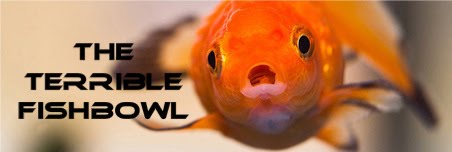
It was important to me when first starting this project to think about the two types of fish which are most frequently harmed by the fish bowl craze; the betta and the goldfish. I decided to start with the betta both because it would be a smaller, and more manageable project price-wise, and because I couldn't for the life of me find a single bowl larger than 3 gallons. Anywhere. The goldfish would have to wait.
Anyway, to the left is what I initially came up with. I have since added many more plants, but this would be really nice just as it is, or with silk plants, should you not want to hassle with live ones. Pictured is a single live aponogeton, grown from a bulb purchased in the Wal-Mart aquatics section.
This would be a great project for a college student wanting a small pet. It is small without being totally cramped, and everything is made from practically unbreakable plastic. Need to take your fish home with you over breaks? No problem! Just unplug the filter and heater, empty halfway and carry out the door. Half-full this weighs approximately 12 pounds.
Here are the supplies I started with for my betta bowl:
- 2.5 gallon plastic drum shaped fish bowl purchased
here for a total of $12.74, including shipping. While I wouldn't dare go any smaller, this is a sufficient size, and rather large as far as fish bowls go. It is 10.5 inches wide and tall. Nearly 6 inches deep.
- Nano filter made by Red Sea, purchased
here for $17.98, including shipping. Note, that you cannot use this filter if you buy a
glass fish bowl. This is because the lip it will hang on is
round. In order to make it fit I cut two slits in the rim so it could be bent, and the filter could be jammed on. This is not difficult to do, but would be impossible with glass.
- 7.5 watt mini heater, purchased
here for $9.40, free shipping. This is pre-set, meaning it will heat the water about 5-8 degrees above room temperature. Since my house stays (like most) in the low 70s, it heats to a perfect 78-80 degrees. If your home remains in the
high 70s or low 80s, you could go without a heater. If it fluctuates a lot you'll want to go with something like
this, which is harder to conceal, but has a thermostat which maintains a consistent temperature.
- Ordinary aquarium gravel, water dechlorinator, airline tubing for "stress free" water changes (to be described later), and a ceramic cup I had sitting around the house for a hiding spot.
All costs included, this should run under $50. Not bad for a fully functioning aquarium.


